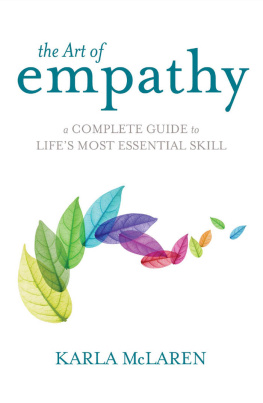Praise for Empathy Works
With an engaging style, thoughtful research, and wisdom, Sophie Wade articulates the most critical skill of great leaders and companieshow they listen to, empathize with, and react to their employees and customers. A highly recommended read for leaders and aspirational leaders of tomorrow.
Norman de Greve, CMO , CVS Health
The bar continues to rise for more inclusive workplaces, and empathy is a trait and practice all leaders need to have in their portfolio, today. Based on her many years of experience advising organizations, Sophie Wade understands this and provides valuable insight here into making the case for empathy in business and the benefits it can bring to organizations of all sizes.
Karyn Twaronite, a global leader in Diversity, Equity & Inclusiveness
The past two years have broken all the conventions of work and Empathy Works makes a convincing case for reframing all aspects of corporate life to make it work more effectively for people and the heart of a companys strategy.
Mark Read, CEO , WPP
The assumption that individuals turn up for just a paycheck is clearly outdated. Our expectations of work and the value of work have changedand its not just about Gen Z. Increasingly we all expect to see the diversity of our own experiences understood and reflected in our companys culture, including work practices that allow for more flexibility and celebrate inclusivity. Empathy Works is an essential guide to developing one of the most critical leadership tools in the modern workplace. Transactional conversations that focus on the job at hand may seem time efficient, but as Sophie Wade illustrates, through a series of case studies and exercises, building empathy with colleagues and customers is key to establishing trust, unlocking creativity, and is an important source of competitive advantage.
Paulette Rowe, CEO , Integrated and E-commerce Solutions, the Paysafe Group
To Liam & Gigi
You inspire me to be a better person and mother.
This book is for you. It is my impassioned contribution
to more positive and productive working lives.
With much love.
Introduction
I t was after dinner, at the end of a multi-day conference for business owners in 2018, and I was chatting with another woman at my table, Jenn, the Founder and CEO of a book-keeping and consulting firm.
I simply cannot fill three new associate-level positions, Jenn told me. Hiring new associates has been getting harder each year, but now my business is actually threatened by my inability to recruit the people I need.
I understood her dilemma. The accounting/book-keeping sector is one of the fields where digitalization has already been replacing many entry-level tasks and even some entire jobs. I could imagine that younger folks, aware of these trends, would be less likely to look for a jobor even consider a careerin this industry. They would have valid reason to be concerned their job might be automated away.
Jenn and I discussed the long-term problem and a potential strategy of liaising with local colleges to connect with, pitch, and convince future graduates. However, that would not address her immediate needs. We dug deeper to look for other solutions.
My company is very customer-oriented, Jenn said. Account executives are on-site at client locations for every meeting to review documents and input data. We have always differentiated ourselves from our competition with our personal touch.
What if your consultants used video conferencing for client meetings? That would free up their time for other clients by saving the commuting to and from each location. Documents could be shared electronically and reviewed together with clients online. Questions could be asked before the associate inputs the data. It doesnt solve the hiring problem, but it would optimize your current employees time while you look for more candidates.
Jenn shook her head. That wont work. Our commitment is to keeping our customers businesses alive, and a key way we do this is through our dedicated on-site service and support.
This founder is a tough cookie. She has been running her own business for more than twenty years while raising four kids. We had already had a livelyand productivediscussion two years before about workplace flexibility. I cared about finding a way for her company to get through this tough patch.
We went back and forth again and again. I proposed more ideasschedules, logistical arrangements, and shared resourcesthat might ease or resolve the current issue.
That wont work, Jenn said.
I explained that updating technologically was the future of her industry, and any tasks or jobs at risk would be absorbed in the process. Candidate reticence about obsolescence could then be put to rest.
No, that wont work, she said again.
Jenn was adamant. After more than half an hour of proposing solutions to no avail, I was feeling desperate. She was determined to maintain her setup, which, she said, helped her clients stay in businessand that was her immutable commitment.
That is when I had an epiphany: I had been empathizing with Jenn and trying to fix her problem, while she was empathizing with her clients and trying to ensure their needs continued to be met. My mistake. I reframed the message.
How about you position the video conferencing application as how you serve your clients. Upgrading how you service them, adopting new technology, is how you help them adapt for the future and enable them to stay in business?
Jenn stopped. She said nothing. This time, my approach was aligned with how she saw the world and the clients issues she was sensitized to.
I held my breath. I might have found the message and delivery that worked. It was the same proposition that I had mentioned at the beginning of our talk; however, now I had explained it as an experience Jenns clients could benefit from, rather than as a convenient solution to deal with a staffing problem that should not affect her clients.
Within three months, Jenn hired a Millennial with technical skills who helped her develop a digital strategy for the company and upgrade to use video conferencing to service her clients much more efficiently. Shifting her approach to how she fulfilled her commitment demonstrated a mindset that understands that future iterations may require altering the model, methodology, or means of delivery, while upholding the same quality of service.
We both benefited from our interaction. Personally, I learned much more about extending my empathetic understanding. I did not fully recognize until sometime afterwards that there had been a significant disconnect at the beginning of our discussion, when I did not realize how deeply Jenn empathizes with her clients. Because of her dedicated attention to their issues and tapping into what they were going through, Jenn interpreted my suggestionswhich were geared to addressing her problemsas discordant with her strategic orientation. So long as I did not relate any potential solutions to her clients experiences and how they would be taken care of, my words would fall on deaf ears. And they had! I could have short-circuited some frustrating moments if I had empathized with Jenns consideration of her clients situations and presented sooner how technology-based options would work for all parties, especially her clients.
From my perspective, the positive outcomes were also the important steps Jenn took to support sustainable growth for her business:
Reviewing business processes with a long-term strategic perspective while staying true to her dedicated customer focus, commitments, and connections
Hiring someone with a relevant perspective and skills to develop and implement appropriate digital tools for her associates to serve her clients effectively










